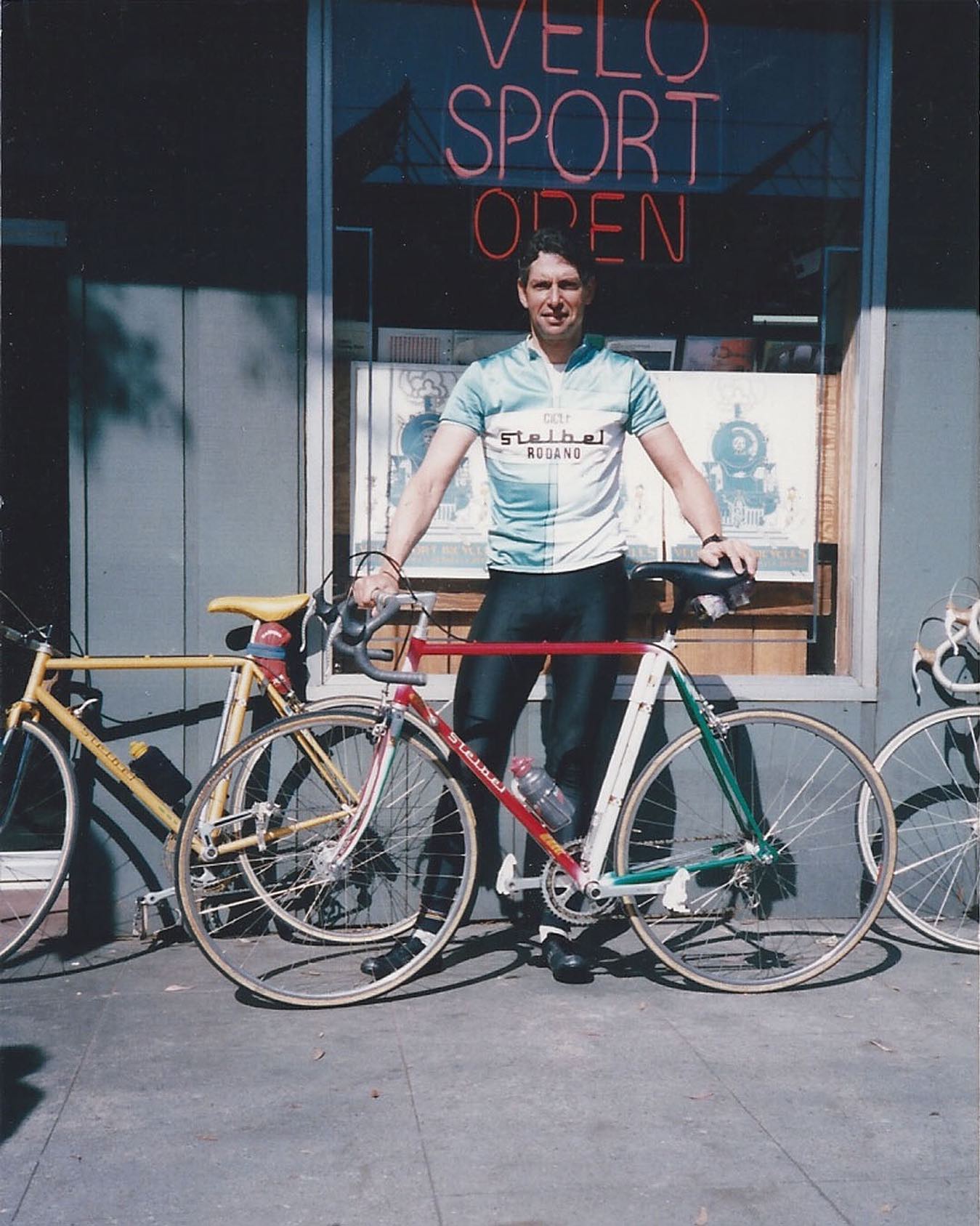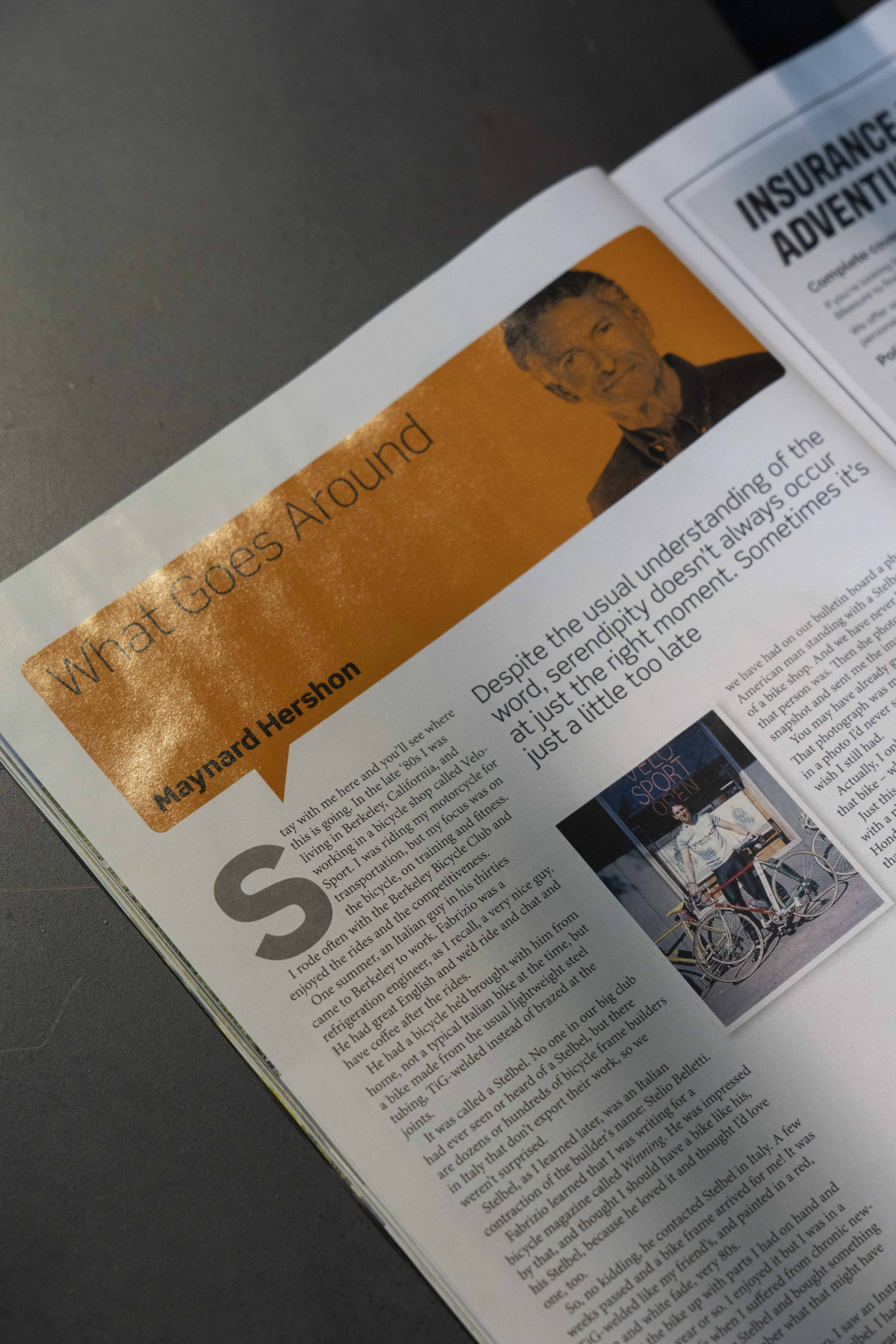I remember that afternoon at Stelio’s house very well.
I had just met him, and I was very excited to sit at the table with him and hear all those anecdotes. Lina had made us coffee, and after serving it, she went to the bedroom to look for “the folder.” She returned with a bundle of newspaper clippings and photos that documented Stelio’s work over the years.
Initially, I thought Stelbel had always remained a local reality, but to my surprise, Stelio handed me a photo of a guy dressed in a Stelbel uniform, showing his bike with a “Tricolore” paint job in front of a store window. The sign said “Velo Sport,” and just below it was the word “Open.”

“My friend from America sent me this,” Stelio said. “He lives in California, and over the years, I’ve sold some bicycles in the United States.” I immediately thought it was incredible. I distinctly remember how that photo had impressed me.
Later on, I didn’t think about that episode anymore until one day, a gentleman named Maynard Hershon, a great enthusiast of bicycles and motorcycles, wrote to us. With the revival of the Stelbel brand, he wanted to share his wonderful experience with Stelbel bicycles in the 80s.
At the time, he lived in Berkeley, California. On instinct, I replied by sending him a scan of that photo I had seen many years ago at Stelio’s house. We had found our man.

We stayed in touch, Maynard is a wonderful person and an excellent writer. Recently, he shared a great article with us that he wrote for an English magazine focusing on motorcycling.
In it, he describes this very episode and emphasizes how special Stelio’s contribution to the world of racing motorcycle frames has been.
We present it to you below.
What Goes Around
Stay with me here and you’ll see where this is going. In the late-’80s I was living in Berkeley, California, and working in a bicycle shop called Velo-Sport. I was riding my motorcycle for transportation, but my focus was on the bicycle, on training and fitness.
I rode often with the Berkeley Bicycle Club and enjoyed the rides and the competitiveness.
One summer, an Italian guy in his thirties came to Berkeley to work. Fabrizio was a refrigeration engineer, as I recall, a very nice guy. He had great English and we’d ride and chat and have coffee after the rides.
He had a bicycle he’d brought with him from home, not a typical Italian bike at the time, but a bike made from the usual lightweight steel tubing, tig-welded instead of brazed at the joints.
It was called a Stelbel. No one in our big club had ever seen or heard of a Stelbel, but there are dozens or hundreds of bicycle framebuilders in Italy that don’t export their work, so we weren’t surprised.
Stelbel, as I learned later, was an Italian contraction of the builder’s name: Stelio Belletti.
Fabrizio learned that I was writing for a bicycle magazine called Winning. He was impressed by that, and thought I should have a bike like his, his Stelbel, because he loved it and thought I’d love one too.
So, no kidding, he contacted Stelbel in Italy. A few weeks passed and a bike frame arrived for me! It was tig-welded like my friend’s, and painted in a red, green and white fade, very ‘80s.
I built the bike up with parts I had on hand and rode it for a year or so. I enjoyed it but I was in a period of my life when I suffered from chronic new-bike fever. I sold the Stelbel and bought something else. I can’t even remember what that might have been. Forgive me.
Fast-forward to two years ago. I saw an Instagram post from Italian framebuilder Stelbel. I hadn’t so-much-as heard the name in all those years. The bike in the Instagram photo was beautiful, elegant and equipped and finished in a way that quietly said “I’m expensive.”
I found the Stelbel website and clicked on Contact. I told them that I’d lived in Berkeley in the ‘80s and had an Italian friend who’d lived there for a short while. While he was there, I said, he asked that you send me a frame, and you did. I worked at a shop called Velo-Sport.
The contact person responded. She said, for years we have had on our bulletin board a photo of an American man standing with a Stelbel in front of a bike shop. And we have never known who that person was. Then she photographed the old snapshot and sent me the image.
It was me, three decades earlier, in a photo I’d never seen, posed behind a bike I wish I wish I still had.
Actually, I only THOUGHT I wished I still had that bike – when…
Just this morning on Facebook, I saw a post with a photo of Mike Hailwood with a ‘60s Honda Grand Prix roadracing motorcycle. At that time, as you may know, Honda could and did build wonderful, world-beating engines, but their frames were scary bad. Treacherous.
According to commenters there on Facebook, Hailwood, defying Honda, went to Ken Sprayson at Reynolds and asked him to build a frame to tame the nearly unrideable Honda. Sprayson, widely regarded as a framebuilding magician, built a frame but Hailwood did not love it.

Then, Hailwood went to an Italian framebuilder who built Hailwood a frame he raced and won on. I couldn’t believe my eyes when I read that Italian craftsman’s name. So I did what you’d have done: I Googled his name…
And it was true! The man who built the Stelbel bicycle frame I sold so casually years ago built a successful 500cc class Grand Prix frame for Mike the Bike: Stelio Belletti.
Stelio Belletti passed away on October 5th, 2023. Godspeed, signore Belletti…

